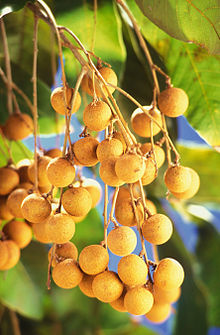Dimocarpus
| Dimocarpus | |
|---|---|

| |
| Dimocarpus longan fruit | |
| Scientific classification | |
| Kingdom: | Plantae |
| Clade: | Tracheophytes |
| Clade: | Angiosperms |
| Clade: | Eudicots |
| Clade: | Rosids |
| Order: | Sapindales |
| Family: | Sapindaceae |
| Tribe: | Nephelieae |
| Genus: | Dimocarpus Lour. (1790)[1][2] |
| Species[3] | |
|
7; see text | |
| Synonyms[3] | |
|
Pseudonephelium Radlk. (1890) | |
Dimocarpus is a genus of trees or shrubs in the flowering plant family Sapindaceae. It includes 7 species which grow naturally in tropical south and Southeast Asia, Malesia, Papuasia, and Australasia, including Sri Lanka, India, the Philippines, southern China, Taiwan, Myanmar, Cambodia, Vietnam, Malaysia, Indonesia, New Guinea, East Timor, far north-eastern Queensland, Australia.[3]
The fruit is edible, with the longan (D. longan) being grown commercially for fruit production.
The species are large evergreen trees growing to 25–40 m tall, with pinnate leaves. The flowers are individually inconspicuous, produced in large panicles. The fruit is an oval drupe 3–5 cm long containing a single seed surrounded by a translucent crisp, juicy layer of fruit pulp and a thin but hard orange or red skin.
Species
[edit]| Image | Scientific name | Common name | Distribution |
|---|---|---|---|
| Dimocarpus australianus Leenh. | Cape York Peninsula, Australia | ||
| Dimocarpus dentatus Meijer ex Leenh. | Malaysia, Sabah | ||
| Dimocarpus foveolatus (Radlk.) Leenh. | Philippines (Luzon, Panay, Samar) | ||
| Dimocarpus fumatus (Blume) Leenh. | S and SE Asia from Sri Lanka and India to E Malesia; D. fumatus subsp. indochinensis in China and Vietnam | ||
| Dimocarpus gardneri (Thwaites) Leenh. | Sri Lanka. | ||
 |
Dimocarpus longan Lour. | Longan | China, Taiwan, Vietnam and Thailand |
 |
Dimocarpus malesianus[4] | Alupag | Sarawak, Malesia |
| Dimocarpus yunnanensis (W.T.Wang) C.Y.Wu & T.L.Ming | China |
References
[edit]- ^
Leenhouts, Pieter W. (1994). "Dimocarpus Lour.". In Adema, F.; Leenhouts, P. W.; van Welzen, P. C. (eds.). Sapindaceae. Series I, Spermatophyta : Flowering Plants. Vol. 11. Leiden, The Netherlands: Rijksherbarium / Hortus Botanicus, Leiden University. pp. 511–519. ISBN 90-71236-21-8. Retrieved 5 Dec 2013.
((cite book)):|work=ignored (help) - ^ "Dimocarpus Lour". Germplasm Resources Information Network. United States Department of Agriculture. 2006-03-29. Retrieved 2010-01-19.
- ^ a b c Dimocarpus Lour. Plants of the World Online. Retrieved 28 October 2023.
- ^ Lithanatudom, Suparat K.; Chaowasku, Tanawat; Nantarat, Nattawadee; Jaroenkit, Theeranuch; Smith, Duncan R.; Lithanatudom, Pathrapol (2021-03-09). "A First Phylogeny of the Genus Dimocarpus and Suggestions for Revision of Some Taxa Based on Molecular and Morphological Evidence". Scientific Reports. 7 (1): 6716. doi:10.1038/s41598-017-07045-7. PMC 5532229. PMID 28751754.
Further reading
[edit]- Bean, A. R. (March 2005). "The Taxonomic status of Dimocarpus leichhardtii (Benth.) S.T.Reynolds" (PDF). Australasian Systematic Botany Society Newsletter. 122 (March). Australasian Systematic Botany Society Inc.: 7. ISSN 1034-1218. Retrieved 15 Dec 2013.
- "Dimocarpus Lour". Atlas of Living Australia.
 Media related to Dimocarpus at Wikimedia Commons
Media related to Dimocarpus at Wikimedia Commons
Text is available under the CC BY-SA 4.0 license; additional terms may apply.
Images, videos and audio are available under their respective licenses.
